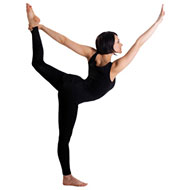- Aromatherapy (36)
- Benefits of Yoga (282)
- Home Remedies (1087)
- massage therapy (9)
- Preventive Therapy (135)
- Running (41)
- Skin Care (15)
- Stress Relief (25)
- Stretching (5)
- walking (33)
- Womens Health (14)
- Yoga Benefits for Pregnant Women (16)
- Yoga Benefits for Students (3)
- Yoga for Children (11)
- Yoga for Holistic Living (37)
- Yoga for Midlife Crisis (3)
- Yoga for Senior Citizens (2)
- Yoga for the Workplace (1)
- Yoga Health Tips (185)
- Yoga Practice during Menstruation (5)
Yoga King of Dance Pose: Good Stretch For The Chest Muscles And Aligns The Vertebrae

The King of Dance pose or Nataraja asana is a flowing pose. It is also known as the Lord of Dance Pose and derives directly from ancient Hindu traditions and Nataraja, the Hindu God Shiva and his mythical dance. The dance routine is believed to be representative of the energy flowing through the universe. It is extremely beneficial as a balancing pose and is also useful for its other benefits. It acts as a stretching exercise for the body, both upper and lower regions simultaneously. It also strengthens the legs, and tones the hip and thigh muscles. The King of Dance pose also provides a good stretch for the chest muscles and aligns the vertebrae. It is in fact restorative for the spine and helps to make it supple and eliminate stress or strain that results from poor posture.
If you are familiar with yoga you would already be aware that yoga poses no matter how complete they may seem in themselves are not meant to be practiced individually. To derive the benefits of these poses you need to practice yoga in a flowing sequence. This holds true for the King of Dance pose as well, and there are certain postures ideally suited to practice before as preparatory poses and likewise some after.
Preparatory Poses include:
- The Handstand or Adho Mukha Vrksasana
- The One-Legged King Pigeon Pose or Eka Pada Rajakapotasana
- The Cow Face Pose or Gomukhasana
- The Monkey Pose or Hanumanasana
- The Reclining Hero Pose or Supta Virasana
- The Reclining Big Toe Pose or Supta Padangusthasana
- The Upward Bow or Wheel Pose or Urdhva Dhanurasana
- The Urdhva Dhanurasana or Ustrasana
- The Standing Forward Bend or Uttanasana
- The Tree Pose or Vrksasana
- The Hero Pose or Virasana
As a follow up you can practice backbends after completing the King of Dance pose.
The practice or steps in the King of Dance Pose:
Assume the Mountain pose.
- When you inhale bend the right leg back, and with your left hand take hold of the left foot. At the same time extend your right arm forward and completely straight.
- Continue to raise your right arm and simultaneously raise the left leg as high as you can with the help of the left arm.
- Maintain the pose while breathing gently, and keep your view focused just above the horizon.
- Initially you can stay in the pose for one minute and increase the time gradually as your comfort level increases.
- RSS Feeds -
- All posts
- All comments
- Chest Exercises for Men You've hit the gym with a vengeance and your body is responding. You alre...
- The Psoas - Is It Killing Your Back? A number of people complain of pain between their lower back and foot and the cu...
- Equipment For Yoga Yoga exercise equipments may not be mandatory for practicing Yoga but it is u...
- How Does Stretching Help? The concept of stretching before starting any vigorous physical activity is comm...